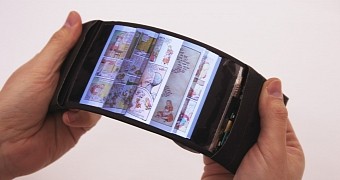Although many handset makers have tried to come up with a flexible smartphone in the last couple of years, it looks like the current technology can't be adapted to such a product yet.
The LG G Flex is a fantastic device, but it's still far from what a flexible smartphone should be. Even if we don't really have a flexible smartphone for the mass-market yet, the mobile display technology seems to be ahead of others since Samsung, and LG both have demoed flexible displays in the past.
The rest of the components (battery, chipset, etc.) must be adapted to the requirements of a flexible smartphone. The good news is researchers at Queen's University's Human Media Lab have found a way to make it work.
They have developed what they believe is the world's first full-color, high-resolution and wireless flexible smartphone, which combines multi-touch with bend input.
Play games or read books using bending gestures
We know very well what multi-touch means, but what about “bend input”? Well, the explanation is pretty simple: you can control the smartphone by bending it.
“When this smartphone is bent down on the right, pages flip through the fingers from right to left, just like they would in a book. More extreme bends speed up the page flips. Users can feel the sensation of the page moving through their fingertips via a detailed vibration of the phone.
“This allows eyes-free navigation, making it easier for users to keep track of where they are in a document,” explains Roel Vertegaal (School of Computing), director of the Human Media Lab at Queen's University.
The device is called ReFlex and comes with an LG Display Flexible OLED touchscreen display that supports HD (720p) resolution. It runs Android 4.4 KitKat operating system and features bend sensors behind the display, which sense the force with which the user bends the screen.
Furthermore, the prototype unit includes a voice coil that enables it to simulate forces and friction via vibrations of the display.
This type of devices might not come to mass-market too soon, but according to Dr. Vertegaal, these flexible or bendable smartphones should hit shelves within the next five years.

 14 DAY TRIAL //
14 DAY TRIAL // 